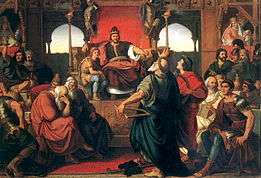445
| Millennium: | 1st millennium |
|---|---|
| Centuries: | 4th century · 5th century · 6th century |
| Decades: | 410s · 420s · 430s · 440s · 450s · 460s · 470s |
| Years: | 442 · 443 · 444 · 445 · 446 · 447 · 448 |
| 445 by topic | |
| Politics | |
| State leaders – Sovereign states | |
| Birth and death categories | |
| Births – Deaths | |
| Establishment and disestablishment categories | |
| Establishments – Disestablishments | |
| Gregorian calendar | 445 CDXLV |
| Ab urbe condita | 1198 |
| Assyrian calendar | 5195 |
| Bengali calendar | −148 |
| Berber calendar | 1395 |
| Buddhist calendar | 989 |
| Burmese calendar | −193 |
| Byzantine calendar | 5953–5954 |
| Chinese calendar | 甲申年 (Wood Monkey) 3141 or 3081 — to — 乙酉年 (Wood Rooster) 3142 or 3082 |
| Coptic calendar | 161–162 |
| Discordian calendar | 1611 |
| Ethiopian calendar | 437–438 |
| Hebrew calendar | 4205–4206 |
| Hindu calendars | |
| - Vikram Samvat | 501–502 |
| - Shaka Samvat | 366–367 |
| - Kali Yuga | 3545–3546 |
| Holocene calendar | 10445 |
| Iranian calendar | 177 BP – 176 BP |
| Islamic calendar | 182 BH – 181 BH |
| Javanese calendar | 329–330 |
| Julian calendar | 445 CDXLV |
| Korean calendar | 2778 |
| Minguo calendar | 1467 before ROC 民前1467年 |
| Nanakshahi calendar | −1023 |
| Seleucid era | 756/757 AG |
| Thai solar calendar | 987–988 |
| Wikimedia Commons has media related to 445. |
Year 445 (CDXLV) was a common year starting on Monday (link will display the full calendar) of the Julian calendar. At the time, it was known as the Year of the Consulship of Valentinianus and Nomus (or, less frequently, year 1198 Ab urbe condita). The denomination 445 for this year has been used since the early medieval period, when the Anno Domini calendar era became the prevalent method in Europe for naming years.
Events
By place
Roman Empire
- Emperor Valentinian III issues an imperial edict against Manichaeism. Heavy penalties are decreed against those who do not denounce the religion and retain Manichaean books.
- Petronius Maximus, prominent aristocrat, is given the title of Patrician. He becomes the most honored of all non-imperial Romans and political rival of Flavius Aetius.
Europe
- Bleda, co-ruler of the Huns, dies in a hunting accident. He is possibly murdered at the instigation of his younger brother Attila, with whom he has ruled since 434. Now about 39, Attila takes the throne for himself and becomes king of the Hunnic Empire.
By topic
Religion
- Domnus II, Patriarch of Antioch, summons a synod of Syrian bishops to confirm the deposition of Athanasius of Perrha.
- Ireland: The Diocese of Armagh is created.
Births
Deaths
- Arsenius the Great, Desert Father
- Bleda, king of the Huns (approximate date)
- Fan Ye, Chinese historian (b. 398)
- Nath Í mac Fiachrach, High King of Ireland
References
This article is issued from Wikipedia - version of the 9/14/2016. The text is available under the Creative Commons Attribution/Share Alike but additional terms may apply for the media files.
